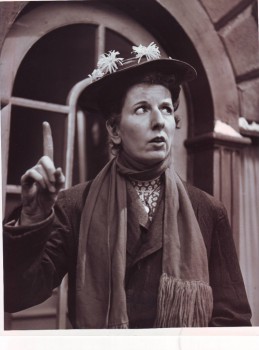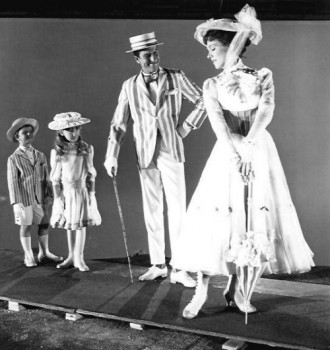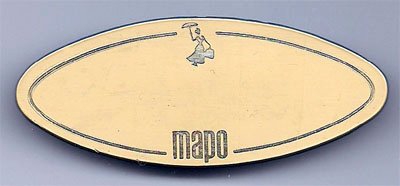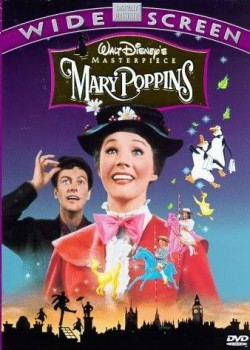50 years ago on August 27th, 1964, a red carpet gala premiere was hosted at the historic Chinese Theater in Hollywood to celebrate Walt Disney’s latest film, Mary Poppins. That auspicious night would change the lives of its attendees forever. Broadway star Julie Andrews became a household name, highly sought after by every studio. The Sherman Brothers moved away from pop radio and became musical legends. And of course, Walt Disney saw his dream of bringing Mary Poppins to the screen come true, which many still consider the greatest film the studio has ever made.
As the film traveled around the world to movie theaters over the next year, the Eastern winds brought magic to every audience member young and young at heart. Mary Poppins may be, as the titular character says, “practically perfect in every way.” To celebrate 50 years of teaching families to cherish their time together, we present 50 Practically Perfect Mary Poppins Facts in chronological order.
1. P. L. Travers first thought of Mary Poppins as a young child making up stories for her sisters. The character was loosely based on her Aunt Helen.
2. The first book, Mary Poppins, was published in 1934 and became a worldwide phenomenon.
3. Walt Disney was first introduced to the character when his daughters asked him to read the book to them. He immediately saw the potential for a film adaptation.
4. Walt’s first contact with P. L. Travers was in 1938 when he made a bid for the film rights and was denied (the only feature film under his belt at the time was Snow White and the Seven Dwarfs).
5. Disney continued to pester Travers for the film rights over the next twenty years.
6. The first on-screen portrayal of Mary Poppins was in 1949 in a CBS teleplay where she was portrayed by Mary Wickes.
7. Walt’s first in-person meeting with Travers was in 1959 while on a trip to London to visit the set of Kidnapped. This meeting began to convince Travers that it was in her best interest to work with Walt.
8. While wooing Travers, Walt tasked Richard and Robert Sherman to pick their favorite scenes from the four Poppins books and write songs for them. They spent two-and-a-half years writing songs for it, unaware that Walt didn’t have the rights yet.
9. It took the Sheman Brothers two weeks to create the word “Supercalifragilisticexpialidocious.” The Sherman’s were inspired by a word game they used to play as children at summer camp.
10. The concept for “Spoonful of Sugar” came about when Robert Sherman’s son received a polio vaccine at school that was injected into a cube of sugar instead of administered as a shot.
11. In April of 1960, Travers signed a preliminary agreement with Disney. Part of the agreement included a down payment of $100,000 for a script Travers’ wrote herself. The agreement also stipulated that Travers would only sign over the full rights with final script approval.
12. Walt’s first casting choice was Dick Van Dyke for Bert. His decision was based on an interview he saw on TV where Van Dyke lamented that there weren’t enough wholesome family films being made.
13. April of 1961 found Travers spending 10 days in story meetings at Walt Disney’s studio, where she insisted the sessions be recorded so the team had documentation of all of her suggestions and demands. These meetings were primarily with the Sherman Brothers and writer Don Dagradi. Walt chose to be absent for most of the sessions with Travers.
14. Travers disliked the Sherman songs, with the exception of “Feed the Birds (Tuppance a Bag),” and instead requested that Edwardian period songs be used if there must be music (she initially insisted that the film not be a musical).
15. Disney initially looked at big names for the role of Mary, considering Mary Martin, Bette Davis and Angela Lansbury for the title role.
16. Robert Sherman saw Julie Andrews performing with the cast of Camelot on The Ed Sullivan Show on March 19th, 1961, and suggested that Walt consider her for the role of Mary.
17. Walt Disney took a trip to New York City to catch a performance of Camelot. After the show, he introduced himself to Julie Andrews in her dressing room and asked her to play Mary Poppins without an audition.
18. Julie Andrews was in talks with Warner Bros. to play Eliza Doolittle in the film version of My Fair Lady, a role she originated on Broadway. She was hesitant when Walt approached her to play Poppins, but the decision became easier when Warner decided to pass on her for a big name, Catherine Hepburn. (Correction: Audrey Hepburn)
19. To further entice Andrews, Walt hired her husband Tony Walton to design the costumes for the film and gave the happy couple private tours of both his studio and Disneyland.
20. When Andrews agreed to play Mary Poppins, she was three months pregnant and feared Walt wouldn’t want her for the role. Walt was so confident in his casting choice that he agreed to delay production until she was ready.
21. When Walt approached Glynis Johns to play Mrs. Banks, she thought she was being asked to play Mary Poppins. She would only agree to do the film if her character had her own song. Walt asked the Sherman Brothers to give her a number, so they repurposed a cut song called “Practically Perfect” which became “Sister Suffragette.”
22. Julie Andrews gave birth to her first child Emma on November 27th, 1962. She received a surprise call from Travers the next day in her hospital room. It was the first time the two had ever spoken. Andrews was told that she was too pretty to play Poppins, but that she had the right nose for it.
23. To prepare for playing a British character, Dick Van Dyke worked on his dialect with actor J. Pat O’Malley. Van Dyke blames his poor accent in the film on having an Irish coach who he claims wasn’t any better. O’Malley is an uncredited voice in the “Supercalifragilisticexpialidocious” sequence and also voiced Jasper in 101 Dalmatians and Colonel Hathi in The Jungle Book.
24. When Van Dyke got ahold of the script after being cast as Bert, he requested to also play Mr. Dawes Sr. Walt told him nobody would believe him in the role and dismissed his request, so Van Dyke had the makeup department disguise him as an old man so he could give Walt a proper audition.
25. Filming began in late August of 1963. Production on Poppins was so big that all four soundstages on the Disney studio lot were being used on the film, which was shot entirely indoors at the Disney Studio.
26. The first scenes filmed were for the “Jolly Holiday” sequence so they could get the scene into animation right away. Milt Kahl designed most of the characters in the animated sequence and was responsible for the fox. Frank Thomas and Ollie Johnston animated the penguin dance and famously complained that Dick Van Dyke kept stepping on their penguins while they were figuring out where to place the characters.
27. The actors and dancers spent six weeks rehearsing the dance for “Step in Time.” The choreographers were worried that the 9-minute number would be shortened, so they produced a demo reel of the rehearsal for Walt to prove that it shouldn’t be shortened. Instead, Walt increased the length of the sequence based on what he saw in their reel.
28. Petro Vlahos developed the sodium vapor camera used during the “Jolly Holiday” sequence, which was a retrofitted old three-strip Technicolor camera. The prism inside the camera was so difficult to replicate that only one camera was ever created for this process at Disney, which was used for many years from 1961 (The Parent Trap) until its retirement in 1990 (Dick Tracy).
29. The mechanical robin that sings with Julie Andrews during “Spoonful of Sugar” is credited as being the first audio animatronic. Walt formed a division of WED Enterprises that would exclusively work on these figures for the 1964 World’s Fair called the Manufacturing And Production Organization, or MAPO for short. The development of this acronym was a nod to the film it was created for (MAry POppins). A silhouette of the flying nanny is their logo, which appeared on employee name tags within that division.
30. Director Robert Stevenson gave Ed Wynn freedom to adlib his scenes and deviate from the script for his role as Uncle Albert. The script described the character as having a Viennese accent, which Wynn didn’t attempt in his portrayal of the character.
31. Matthew Garber, who played Michael, was so afraid of heights that in addition to his salary, he was given 10 cents for every take during the suspended “I Love to Laugh” sequence.
32. Mary’s parrot doesn’t reveal that he can speak until the end of the film. When he does speak, the voice is none other than David Tomlinson, who plays Mr. Banks.
33. Walt allowed director Robert Wise to visit the set and view dailies of Julie Andrews, who cast her in The Sound of Music based solely on that visit.
34. The kite at the end of the film is a metaphor for the broken family being put back together. George mends the kite and his relationship with Jane and Michael. Winifred using her suffragette ribbon as the tail is symbolic of her renewed commitment to her family.
35. Walt visited retired actress Jane Darwell at the Motion Picture Country Home where she was living. She was reluctant to return to the screen, but Walt convinced her to play the bird woman and hired a limo to drive her to the set for her scene, which was the final day of shooting.
36. Walt did not invite Travers to the premiere at the Chinese Theater, figuring it would be easier to include her at the film’s London premiere. Travers sent him a telegram letting him know that she was going to be in the States at that time and requested a ticket.
37. After the premier, P. L. Travers told Walt they had a lot of work left to do and demanded further edits, including removing the “Jolly Holiday” sequence. Walt denied her request and the film opened in New York City two days later.
38. The film was so successful in its theatrical release that it continued playing throughout 1965, giving it a chance to compete against Julie Andrews’ third film The Sound of Music. It was the highest grossing film of 1965 (The Sound of Music came in second).
39. The success of Mary Poppins gave Walt the money needed to buy 27,500 acres of swampland near Orlando, FL. This land is currently home to Walt Disney World.
40. Julie Andrews was nominated for a Golden Globe for Best Actress in a Musical or Comedy, up against Audrey Hepburn for My Fair Lady. In her acceptance speech, she thanked Jack Warner, an inside joke because if she had been cast in My Fair Lady, she wouldn’t have been free to play Mary Poppins.
41. Mary Poppins was nominated for 13 Academy Awards, winning 5 Oscars (Best Actress – Julie Andrews, Best Song – “Chim Chim Cher-ee,” Best Score – Richard & Robert Sherman, Best Visual Effects and Best Film Editing).
42. The soundtrack spent 14 weeks at number 1 on the Billboard charts in 1965, outselling albums released that same year by The Beetles, Elvis Presley and The Rolling Stones.
43. “Feed the Birds (Tuppance a Bag)” was Walt’s favorite song in the film. Until his passing, he would frequently visit the Sherman Brothers’ office and say “Play it” until his passing in December of 1966.
44. A Mary Poppins attraction was developed, but never built, for the Magic Kingdom at Walt Disney World. The attraction would have placed guests on merry-go-round horses and transported them through the “Jolly Holiday” sequence. It was reconsidered later as an attraction for the United Kingdom pavilion at Epcot.
45. Founder of the Walt Disney Archives Dave Smith spent many years searching for the snow globe from the “Feed the Birds” sequence. He finally found it in a janitor’s office on the studio lot. The janitor explained that he found it in the trash one day, but thought it was too pretty to throw away. He had no idea the trinket was from Mary Poppins.
46. The film debuted on home video in 1981. Unlike most of Disney’s film library, Mary Poppins has never been taken out-of-print despite being re-released every five years. It was also the first film Disney released on DVD.
47. The Walt Disney Company made numerous attempts at getting Travers on board for a sequel, which almost happened in the mid 1980’s when she cowrote a script with Brian Sibley for Mary Poppins Comes Back. The film fell through due to management changes at Disney and casting challenges.
48. When Cameron Macintosh approached Travers for the stage rights in the 1990’s, she made sure that the contract included a stipulation that only British writers could be involved and that the show had to follow the plot of the books, not the film.
49. Macintosh stayed true to his word, but realized a stage musical would not be successful without the Disney music. The show finally debuted in London’s West End in 2004 (and Broadway in 2006) with additional songs written in the Sherman style by George Styles and Anthony Drewe. The show is a coproduction between Cameron Macintosh and Disney Theatrical.
50. In December of 2013, the Library of Congress selected Mary Poppins for preservation in the National Film Registry. It is the only live action Disney film to be selected.
In the 50 years since Walt Disney introduced the world to his version of Mary Poppins, many have tried to recreate the success both inside and outside of Disney. No film has ever come close to topping it. I believe Samuel Goldwyn put it best in his letter to Walt after seeing the film. “Once in a lifetime – and only once – a picture comes along which cannot be compared to any other and to which no other can be compared. A picture which writes a new page in motion picture history… You have made it – Mary Poppins.”




